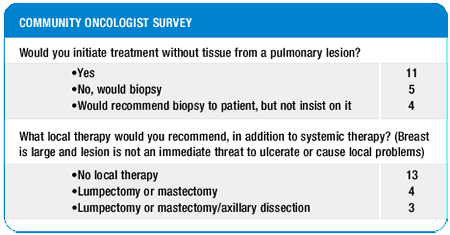| You
are here: Home: BCU 6|2001: Section 2

SHOULD TISSUE HAVE BEEN OBTAINED FROM A PULMONARY LESION?
The characteristic radiologic appearance of these nodules for pulmonary
metastases led me away from putting the patient through an invasive
procedure. I decided to do an in vivo test of diagnosis by observing
the increase or decrease of the lung nodules relative to the breast
mass, assuming that if the breast mass decreased in response to
therapy, the pulmonary lesions would follow suit. Over the course
of this patient’s treatment, this did correlate very well.
I probably would have used the same philosophy even if the tumor
were ER-negative — initiating first-line chemotherapy and observing
for response.
—Kevin Fox , MD
The problem in this patient is the level of confidence that this
is metastatic disease. Obviously, this makes a world of difference
in both her treatment and her plans for the rest of her life. Although
the clinical picture is more than highly suggestive of metastatic
disease, I feel that she deserves the rule-out manner of thinking.
If the patient were willing, my initial recommendation would be
for obtaining lung tissue.
—Patricia Madej, MD
I would absolutely get tissue to confirm the diagnosis of metastases.
Usually my first choice is a CT-guided lung biopsy. If the lesions
are too small, we usually do a video-assisted thoracoscopy to get
the diagnosis. I would not give her a diagnosis of Stage IV disease
— no matter how typical it looked — unless I exhausted
every possibility of obtaining tissue.
—Linda Vahdat, MD

LOCAL THERAPY OF 4cm BREAST MASS
Comments from a panel discussion at the
3rd Annual Lynn Sage Breast Cancer Symposium, October 2001
Time is not of the essence for making a local therapy decision
in metastatic disease. It is okay to see how a patient is doing
and see her back in eight weeks when she’s going to the medical
oncologist anyway to give you an idea of what’s going on as
far as the necessity of local control. There are very few patients
with metastatic disease who need to come to surgery. I would do
it only if I thought we were going to get into local failure problems.
This never occurs quickly, so there is plenty of time to rediscuss
and have the medical oncologist perhaps rethink the systemic treatment.
If the disease is not causing any skin breakdown, a large amount
of pain or anything in particular beyond its presence, observation
might be appropriate.
—Jeanne Petrek, MD
I’m not aware of any data clearly showing the benefit of doing
local therapy. I would side with just watching a patient like this
and continuing the systemic therapy. This would change if it became
a local problem, if the disease were breaking down the skin, etc.
But other than that, I’m not aware of any data to support removing
the primary lesion.
—William Gradishar, MD
It’s an interesting biological question that you could argue
one of two ways. The kidney cancer people have data suggesting that
if you take out a primary renal cell carcinoma in the presence of
metastasis, you live longer 26 . On the flip side, the “Folkmanesque”
approach to tumor dormancy 27-32 suggests that the primary tumor
might be producing something that suppresses the metastases —
if you take out the primary tumor, the metastatic tumor might explode.
You can call it either way from a biologic standpoint, but in breast
cancer, we just simply don’t have any decent data.
— George Sledge, MD
|
Case history continued:
The patient was started on the LH-RH agonist goserelin and
had a partial response in both the breast and pulmonary nodules.
The patient was asymptomatic except for some mild vasomotor
menopausal symptoms.
|
Page
2 of 6
Previous
page | Next page
|
